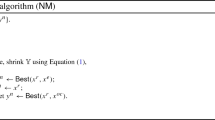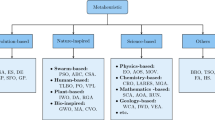Abstract
One of the fundamental difficulties in engineering design is the multiplicity of local solutions. This has triggered much effort in the development of global search algorithms. Globality, however, often has a prohibitively high numerical cost for real problems. A fixed cost local search, which sequentially becomes global, is developed in this work. Globalization is achieved by probabilistic restarts. A spacial probability of starting a local search is built based on past searches. An improved Nelder–Mead algorithm is the local optimizer. It accounts for variable bounds and nonlinear inequality constraints. It is additionally made more robust by reinitializing degenerated simplexes. The resulting method, called the Globalized Bounded Nelder–Mead (GBNM) algorithm, is particularly adapted to tackling multimodal, discontinuous, constrained optimization problems, for which it is uncertain that a global optimization can be afforded. Numerical experiments are given on two analytical test functions and two composite laminate design problems. The GBNM method compares favorably with an evolutionary algorithm, both in terms of numerical cost and accuracy.
Similar content being viewed by others
References
Bäck, T. 1996: Evolutionary Algorithms in Theory and Practice. Oxford: Oxford University Press
Barhen, J.; Protopopescu, V.; Reister, D. 1997: TRUST: a deterministic algorithm for global constrained optimization. Science 276, 1094–1097
Berthelot, J.-M. 1999: Composite Materials: Mechanical Behavior and Structural Analysis, Mechanical Engineering Series. Berlin: Springer
Duda, O.R.; Hart, P.E.; Stork, D.G. 2001: Pattern Classification, 2nd edn. New York: John Wiley & Sons
Durand, N.; Alliot, J.-M. 1999: A combined Nelder–Mead simplex and genetic algorithm. Available at: http://www.recherche.enac.fr/opti/papers/
Goldberg, D.E.; Voessner, S. 1999: Optimizing global-local search hybrids. In: GECCO 99 – Genetic and Evolutionary Computation Conference (held in Orlando), pp. 220–228
Haftka, R.T.; Gürdal, Z. 1993: Elements of Structural Optimization, 3rd edn. Boston: Kluwer Academic Publishers
Hickernell, F.J.; Yuan, Y.-X. 1997: A simple multistart algorithm for global optimization. OR Trans. 1(2), 1–11
Hu, X.; Shonkwiller, R.; Spruill, M.C. 1994: Random Restarts in Global Optimization. Technical Report, School of Mathematics, Georgia Institute of Technology, Atlanta
Le Riche, R.; Guyon, F. 2001: Dual evolutionary optimization. In: Collet, P.; Lutton, E.; Schoenauer, M.; Fonlupt, C.; Hao, J.-K. (eds.) Artificial Evolution, Lecture Notes in Computer Science, No. 2310, selected papers of the 5th International Conference on Artificial Evolution (held in Le Creusot), pp. 281–294
Luersen, M.A.; Le Riche, R. 2001: Globalisation de l’Algorithme de Nelder–Mead : Application aux Composites. Technical Report, LMR, INSA de Rouen, France; in French
Michalewicz, Z.; Schoenauer, M. 1997: Evolutionary algorithms for constrained parameter optimization. Evolut. Comput. 4(1), 1–32
Minoux, M. 1986: Mathematical Programming: Theory and Algorithms. New York: John Wiley & Sons
Moscato, P. 1989: On Evolution, Search, Optimization, Genetic Algorithms and Martial Arts: Towards Memetic Algorithms. Caltech Concurrent Computation Program, C3P Report 826
Nelder, J.A.; Mead, R. 1965: A simplex for function minimization. Comput. J. 7, 308–313
Okamoto, M.; Nonaka, T.; Ochiai, S.; Tominaga, D. 1998: Nonlinear numerical optimization with use of a hybrid genetic algorithm incorporating the modified Powell method. Appl. Math. Comput. 91, 63–72
Rockafellar, R.T. 1976: Lagrange multipliers in optimization. In: Cottle R.W.; Lemke C.E. (eds.) Nonlinear Programming, Proc. SIAM-AMS, 9, 145–168
Shang, Y.; Wan, Y.; Fromherz, M.P.J.; Crawford, L. 2001: Toward adaptive cooperation between global and local solvers for continuous constraint problems. In: CP’01 Workshop on Cooperative Solvers in Constraints Programming (held in Pahos)
Syswerda, G. 1991: A study of reproduction in generational and steady state genetic algorithms. In: Rawlins, G.J.E. (ed.) Foundations of Genetic Algorithms. San Mateo: Morgan Kaufmann
Törn, A.A. 1978: A search-glustering approach to global optimization. In: Towards Global Optimization 2, pp. 49–62
Törn, A.A.; Zilinskas A. 1989: Global Optimization. Berlin: Springer-Verlag
Wright, M.H. 1996: Direct search methods: once scorned, now respectable. In: Dundee Biennial Conference in Numerical Analysis (held in Harlow), pp. 191–208
Author information
Authors and Affiliations
Corresponding author
Rights and permissions
About this article
Cite this article
Luersen , M., Le Riche , R. & Guyon , F. A constrained, globalized, and bounded Nelder–Mead method for engineering optimization. Struct Multidisc Optim 27, 43–54 (2004). https://doi.org/10.1007/s00158-003-0320-9
Received:
Revised:
Published:
Issue Date:
DOI: https://doi.org/10.1007/s00158-003-0320-9




